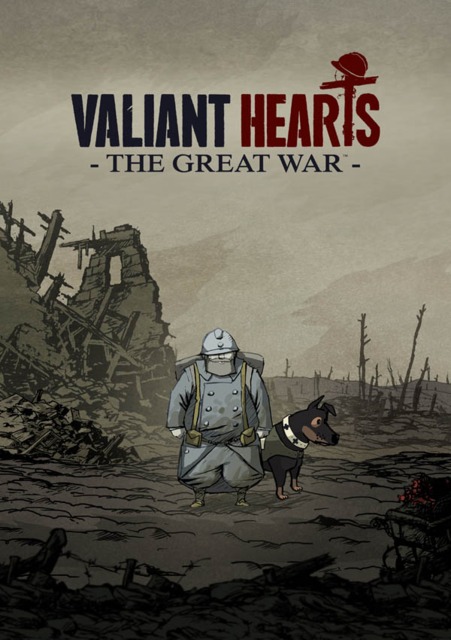Not a fun game but an important one nonetheless
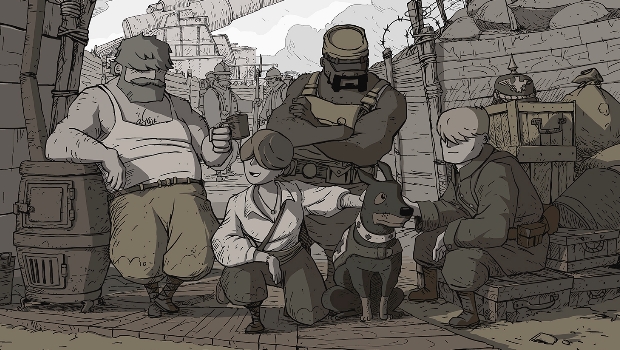
Valiant Hearts: The Great War begins with the start of the first World War, narrating the events that kicked off the conflict. The story then follows a handful of different characters: Karl, Emile, Freddie, Anna, and Walt. Karl, a German man living in France with his wife and newborn child, is deported to Germany and drafted into the army. Karl’s father-in-law, Emile, is inspired by these events and enlists for the French, hoping to help end the war sooner for his daughter and grandchild. Freddie is an American who was vacationing in Europe when a German bombing killed his wife, causing him to enlist in hopes of revenge against the evil Von Dorf. Anna was studying to become a veterinarian when her scientist father was captured by the Germans; she then joined up as a nurse, saving lives and making her way ever closer to her father’s rescue. The final member, Walt, is actually a dog who befriends the others and helps them in a variety of situations. The story follows the lives of each of these five characters as they intertwine and separate over the course of the first three years of World War I.
From the beginning, it’s clear that the developer chose to mix real events with a dash of fiction. While you visit real battles and locations, the things you do as each of the characters is likely not entirely truthful to what happened. As you might expect, there’s a bit of “one-man/woman army” going on in many of the levels, as you push the lines forward almost entirely on your own. Still, the game manages to keep things just believable enough that you could see the fictitious events as something that might have happened--barring a few absurd sequences. As someone who didn’t know much about World War I prior to playing this game, I feel like I came away learning a good deal I didn’t know and, as someone who’s never liked history much, I appreciate the way the developer managed to mix history along with emotional investment and intriguing gameplay to avoid the boredom such a product could have. Adding to this are the various bonus items you can find in each level. These items give a small history lesson relating to the item in question, such as a urine-soaked rag that informs the player of how such a thing could protect from the effects of chlorine gas. Since these are optional, players can choose to avoid them if they don’t care or seek them out to learn more.
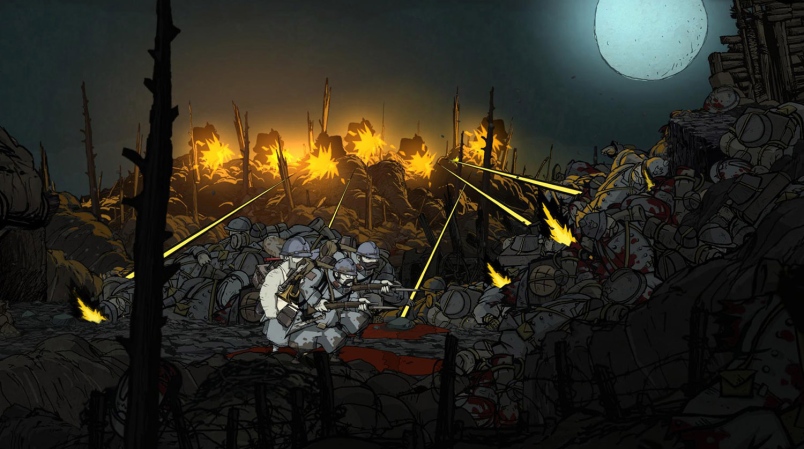
One thing that is weird about the game, however, is the strange tonality shifts that occur early on. In the first chapter (of four, made up of multiple levels each), the tone feels inconsistent. A good early example is how you play a level in a camp full of soldiers who are still filled with excitement and pride fighting for their country, complete with joyous revelry and boisterous drinking, just to have the next level show you the horrors of chemical weaponry. Also noteworthy are the sections where you drive a vehicle and must avoid obstacles in the road in-time to a piece of classical music. These rhythmic scenes are a lot of fun, but the whimsical representation of the event brings about that same atonal sensation. While sudden shifts in disposition are likely accurate to real wartime behavior, as soldiers don’t quite realize the horrors of war until they experience them firsthand, they can also come off as jarringly bipolar. After the first chapter and a half or so, the tone sticks almost entirely to the depressing and emotional style that best suits the events of the game. These later chapters felt more honest to me, really highlighting the horrors of the first World War: trench warfare, civilian casualties, the sheer number of bodies thrown at conflict lines. It all culminates with a brutally honest and shocking ending, tingeing the final moments with a bittersweet sensation and reminding you that the war isn’t even over yet at the game’s conclusion. Through these incredibly affecting scenes, I was able to forgive the game for its early missteps.
When you play Valiant Hearts, it most resembles an adventure game with direct control. You control one of the four human characters, with or without the help of the dog. You traverse various environments and have to deal with particular obstacles to progress. Every so often, you can find things to throw in order to distract foes or knock things down into reach. Most sections are solved by finding some item to remove the obstacle, such as a pair of wire cutters to take care of barbed wire fences. Several levels, especially later on, force you through a chain of item usage and trading with NPCs to get the item you actually need to progress. When the dog is present, you can send him through small holes and under gas to retrieve items or operate levers. Soldiers don’t respond to him at all, so you often use him to get things just out of reach or under the watchful eye of your foes. There are also a few deviations from the gameplay from time-to-time: simplistic vehicle sections, the aforementioned rhythmic dodging sections, and a button-timing minigame to heal soldiers as Anna.
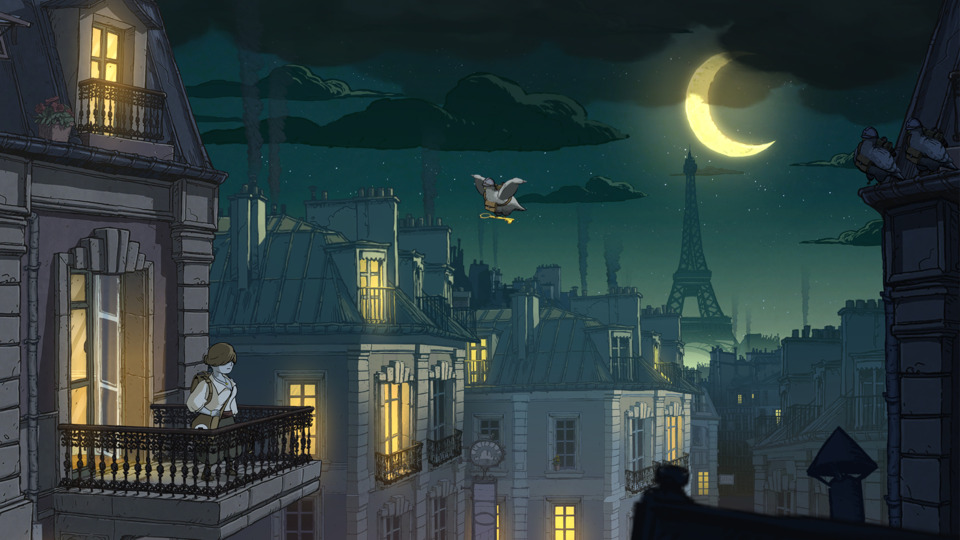
For the most part, the puzzles are extremely easy: you walk around the environment presented to you, noting the places you can’t go and finding any loose items that may help you to proceed. As the game progresses, you often have to jump through more hoops to retrieve the items you need, but it’s never too difficult to backtrack the chain of necessary trades/usages until you find its beginning. This pattern of survey-and-execute never really changes throughout the entire game. In fact, many of the puzzles are far too similar in style. It doesn’t take long to experience everything the game has to offer in terms of puzzle design, aside from a few brief and singular instances. By the end of the game, I had used each mechanic the game had to offer several times and was quite bored with each of them. To make matters worse, many of these sections go on for much longer than they need to, slowing down the action and robbing them of their appeal. While greater length can add to the intensity of fighting for a position in a warzone or the tenseness of sneaking through the woods to avoid enemy soldiers, the long levels also make the repetitive puzzle design that much more tedious.
There are a few others issues to note as well. Some of the puzzles are irritating simply because the game isn’t always forthcoming with what you are expected to do. One instance of this is a prison camp section that has you switching uniforms in order to pass by guards. The uniforms in question don’t look that different in color, making it hard to tell which is which (even as someone who isn’t color-blind, like myself). In addition, a few of the areas you would expect to be able to go as one color are not accessible at all and with no warning. The one saving grace is that there is a tiered hint feature (with more hints unlocking as you need them) that can be used at any time, often giving just enough context to make you realize just what to do in confusing situations like these. The checkpointing is also quite bad in certain sections of the game, usually the ones that require a bit more precision or timing. The worst of these sections have you doing very specific things over and over again until you get it just right. To make matters even worse, the cutscenes or dramatic moments that occur must play out each and every time you encounter them, making them unbearably tedious to try again. Neither of these issues stymied my progress for long, but they hindered what was otherwise a smooth, enjoyable experience.
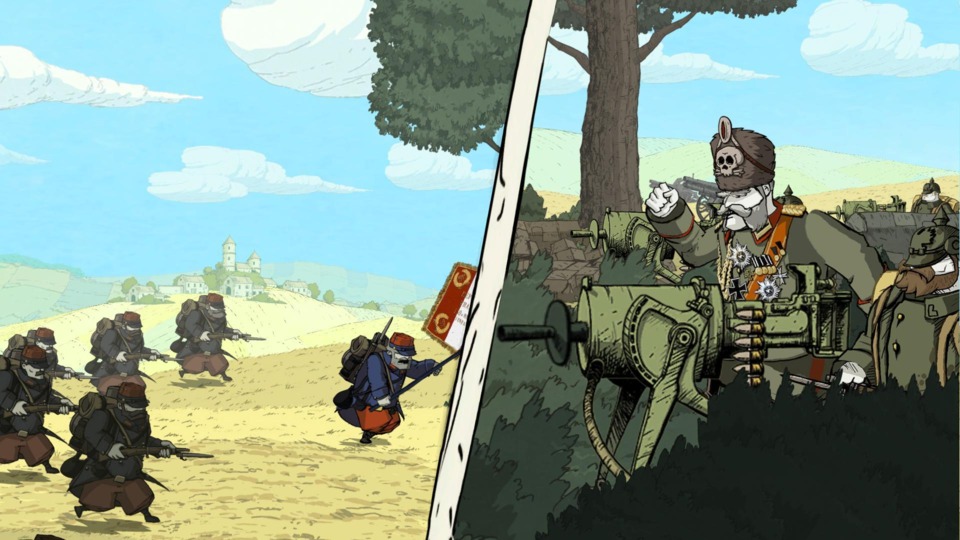
Presentationally, Valiant Hearts is a pure joy. The game uses UbiArt Framework, a graphics engine (used for the previous Rayman games) that allows developers to create art that looks entirely unique. Valiant Hearts utilizes this engine to bring to life a fantastic artstyle, colorful and sharply-defined like a comic book, and deliver some astounding vistas and setpiece moments. Most notable are the absurd levels of detail in certain areas, with multiple dense layers reaching into the background. It is truly a sight to behold in action, dripping with emotion and style while smooth and exciting to watch in action. The soundtrack is also absolutely fantastic, emotionally powerful or subtly intense depending on the situation. It’s predictable in its style--usage of instruments, repeating themes, etc--but the lead audio designer does a superb job at knowing just when to bring the music up and make the player feel something about a given scene. While it isn’t something I would want to listen to outside of the game, as I feel it wouldn’t have quite the same meaning, it adds a great deal of impact to the various emotional scenes throughout the game. Paired together, the artstyle and soundtrack add a lot of believability and emotional investment that would otherwise be lacking, making for a stronger overall package.
Valiant Hearts: The Great War feels like one of those games that gets to do what it wants, fully realizing the emotional gravitas and resonance that it hopes to achieve. In this regard, I absolutely adored this game. While it struggles to find its tone early on, the later chapters of the game are some of the most potent moments I’ve seen in a game in quite some time. Unlike many war games on the market, I actually managed to feel some amount of guilt and respect for the people who fight in any kind of conflict. At the same time, the gameplay just barely managed to hold my interest. There isn’t anything inherently wrong with its minimalist adventure game style, yet I found it much too vague and tiresome at times. More than anything, I just wanted these sections to be over so I could learn more about the characters and the conflict. In the end, however, I’m glad I spent the time playing through this game. If you don’t mind slogging through a bit of repetition, there’s a lot to be learned and respected in Valiant Hearts.
